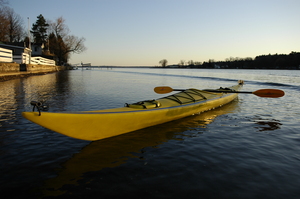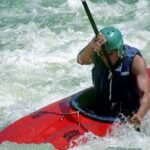Constructing a lightweight canvas kayak is a great way to enjoy being on the water in the great outdoors. With a little epoxy resin, some canvas fabric, and a little wood for framing, a kayak can easily and quickly be built that will provide a solid watercraft for fishing from. Once completed a lightweight canvas kayak will provide many years of enjoyable usage as a quality watercraft.
The things you will need for this project are 3 sawhorses, a tape measure, four 1 ½ foot long 1-by-4’s, a 3 foot long 1-by-4, a 2 ½ foot long 1-by-4, and four 8 foot long 1-by-2’s. In addition to this you will need a drill, a screwdriver bit, some galvanized 1 ½ inch decking screws, some scissors, a needle, outdoor upholstery thread, 20 yards of 5 foot wide canvas, a staple gun, galvanized staples, some epoxy resin, and a paint brush. With these materials in hand, the project can be easily completed in the course of a weekend.
The first step to building your own lightweight canvas kayak is to construct the kayak’s frame. This is accomplished by first building the center frame support for the kayak. This is done by using the drill along with the screwdriver bit and the 1 ½ inch galvanized screws to build a trapezoid that from two of the 1 ½ foot long 1-by-4’s, the 3 foot long 1-by-4, and the 2 ½ foot long 1-by-4. The 2 ½ foot long 1-by-4 forms the bottom of the trapezoid with the 3 foot long one at the top. The 1 ½ foot long 1-by-4’s are on the sides and attached to the 2 ½ foot long and 3 foot long 1-by-4’s with the 1 ½ inch galvanized screws. When making the trapezoid, be sure that the 2 ½ foot is centered 6 inches from either side and parallel to the 3 foot long 1-by-4.
The next step is to set two of the sawhorses a distance of 8 foot apart from one another. Then use the 1 ½ inch screws to attach the remaining two 1 ½ foot long 1-by-4’s vertically to the two sawhorses. Make sure that these stand 1 ½ feet above the sawhorses. These pieces will be the bow and stern of the canvas kayak. Next set the third sawhorse in the center between the other two sawhorses. Now attach the trapezoid that you constructed in the first step vertically to the center sawhorse. Make sure that the vertical 1 ½ foot end pieces are centered in line with the middle of the the trapezoid.
The third step in the construction of the lightweight canvas kayak is to attach the four 8 foot long 1-by-2’s to the bow and stern pieces and the center trapezoidal support frame. This is done by driving the 1 ½ screws through the 1-by-2’s and into the 1-by-4 bow and stern pieces and the center trapezoidal support frame. Make sure that the 1-by-2’s are attached at the edge of the trapezoidal support frame and the bow and stern pieces. Then also be certain that they are parallel to one another. Once this is done the side support pieces of the frame are in place and the kayak’s frame is completed.
The fourth step is to use the staple gun and galvanized staples to attach canvas fabric to the frame. This is done by first stretching the canvas across the top of the kayak’s frame and then stapling the canvas to the 1-by-2 side frame pieces. Once this is done the 1 ½ inch screws that are attaching the frame to the sawhorses need to be removed to allow the frame to be rotated for adding additional canvas to the top and sides of the canvas kayak. Next continue to lay canvas across the kayak’s frame until it is completely covered with canvas. Make sure that you staple the canvas in place in order to secure it to the frame. Once this is completed, use the scissors to cut a 2 ½ foot round hole about 6 to 8 inches in front of the center trapezoidal frame. Then use the needle and outdoor upholstery thread to sew a neat hem around the edge of the hole. This will be the place where one can sit in the kayak to paddle it.
The fifth step is to paint the epoxy resin onto the top, bottom and each side of the kayak. Do this one side at a time and allow about 3 to 4 hours for each side to fully cure before moving on to another side. This will ensure that the epoxy resin has bonded with the canvas and is providing the utmost strength possible. Once every side of the kayak has been painted with the epoxy resin and the resin has fully cured, the kayak is ready to be painted whatever color you desire. Use your desired color of paint to paint the kayak and allow about 24 to 48 hours for the paint to fully dry before using the kayak. At this point the kayak is completed.
This entire project can be completed over the course of about two to three days. Usually it takes one day to construct the frame and to lay the canvas for the kayak. Then it takes another day or two for the painting and drying of the epoxy resin and the painting of the boat. All in all though it is easily a project that a single person should be able to accomplish over the course of a long weekend.
Sources
Personal Experience
“Kayaks: Build Your Own Kayak!,” The Wood Shop
Thomas D. Yost, “Wood Frame Kayak Builder’s Manual,” Yost Werks







